Brown-necked Raven
A species of Crows Scientific name : Corvus ruficollis Genus : Crows
Brown-necked Raven, A species of Crows
Botanical name: Corvus ruficollis
Genus: Crows
Content
Description General Info
 Photo By Lip Kee Yap , used under CC-BY-SA-2.0 /Cropped and compressed from original
Photo By Lip Kee Yap , used under CC-BY-SA-2.0 /Cropped and compressed from original Description
The brown-necked raven (Corvus ruficollis) is a larger bird (52–56 cm in length) than the carrion crow though not as large as the common raven. It has similar proportions to the common raven but the bill is not so large or deep and the wings tend to be a little more pointed in profile. The head and throat are a distinct brownish-black giving the bird its English name, while the rest of the plumage is black glossed with purple, blue or purplish-blue. Like the Common raven, Thick-billed raven and White-necked raven, it is one of the larger raven species. The smaller raven species are the Australian raven, Forest raven, Little raven, Fan-tailed raven and Chihuahuan raven with the Thick-billed raven being the world's largest raven species and the Chihuahuan raven being the smallest. The feathers of this species often fade quite quickly to a brownish black (even the truly black feathers) and the bird can look distinctly brown by the time it moults. The feet, legs and bill are black. The dwarf raven was formerly considered a subspecies (Corvus ruficollis edithae) but this bird now appears to be closer to the pied crow (C. albus) than this species. 
Size
56 cm
Nest Placement
Tree
Feeding Habits
Brown-necked Raven consumes a vast range of foods, including invertebrates, small vertebrates, and plant material. It exhibits diverse feeding behaviors such as foraging, scavenging, and occasionally hunting, even cooperating to flush prey. It also scavenges at human settlements and hides surplus food.
Habitat
Brown-necked Raven thrives in arid environments, favoring semi-deserts, desert plains, mountain foothills, and dry savannas. They are also present in oases, cultivated barren islands, and near human developments. These birds thrive amidst desert flora like tamarisk and saxaul shrubs. Typically found below 2000 meters, they avoid high mountainous areas, except where their range intersects with C. corax in desert plains.
Dite type
Omnivorous
General Info
Feeding Habits
Bird food type
Distribution Area
This species has a wide range across virtually the whole of North Africa, down as far as Kenya, the Arabian Peninsula and up into the Greater Middle East and southern Iran. It lives in a predominantly desert environment visiting oases and palm groves. Food consists of a wide range of items, including carrion, snakes, locusts and other grasshoppers, stranded fish (in coastal areas), grain stolen from bags, dates and other fruits. It is quite fearless when not persecuted but is quick to become wary and shy if too much attention is paid to it. A 2009 Israeli study showed the species to cooperatively hunt lizards, with birds blocking exits while others hunted. 
Species Status
Not globally threatened.
Scientific Classification
Phylum
Chordates Class
Birds Order
Perching birds Family
Crows and jays Genus
Crows Species
Brown-necked Raven